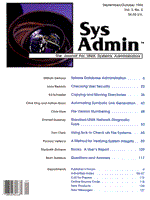
File Version Numbering
Chris Hare Frequently I've wanted to have multiple copies of a file as it went through various stages of rewriting and reworking. Havng used a DEC VAX at various points in my career, I liked the version numbering which VMS provides. To address this I wrote a program called vedit (Listing 1). vedit is a shell program which implements version numbering using a similar scheme to VMS. For each file, vedit checks the name to see if there is a file in the current directory which has a version number. Version numbers are added to filenames by including a semicolon and a number. For example, the file "demo" does not use version numbering, while "demo;2" does. The number 2 indicates that this is the second version of the file "demo". The Bourne Shell script in Listing 1 is simple enough, and is easy to use and understand. However, there are some issues which should be mentioned here. The seimcolon is a special character to the Bourne and Korn shells. It is used as a command separator to allow the user to enter mupltiple commands on the same line. For example, you can write
$ who chare w1 Mar 23 21:40 $ date Sat Mar 26 14:39:35 EST 1994 $ pwd /u/chare/Filecabinet/publish/sysadmin/vi
or you can use the semicolon and write it as
$ who; date; pwd chare w1 Mar 23 21:40 Sat Mar 26 14:40:52 EST 1994 /u/chare/Filecabinet/publish/sysadmin/vi
Consequently, the use of the semicolon in the file name requires some special handling. To access a file under version control without using the vedit command, you must use the backslash to "escape" the meaning of the semicolon to the shell, as, for example,
$ cat demo\;2
To discuss the operation of the shell script in Listing 1, I have numbered it using the UNIX pr command. Line 30 lists the files that contain a semicolon, and replaces all of the text in the file name with blanks. The end result is a list of numbers in reverse sorted order. The result of this list is the last or highest number in the list. If the file is new, then the first version number used is 1. Lines 36 to 58 determine what version number is to be used, and set some variables which will be used later in the script. Lines 63 to 75 copy the original file to the new filenme for editing. Should the copy fail, the user is informed with the error message. The most likely causes of such a failure would be the permissions on the directory involved, or an inability to read the source file. The file is loaded for editing in line 79; upon exit, the script verifies that editing did in fact occur. The diff command in line 85 compares the two files. If no changes were made, then execution jumps to line 117, where the user is told that no changes were made and the newly created file is removed. If changes were made, then the lines and bytes in the file are counted by the wc command in line 104, and the information on the edit is recorded in an edit history file, the name of which consists of the filename plus a .INDEX entension. The information in the index file includes the file name and version, the name of the person who edited it, the date and time, and the lines and byte count of the new file. Line 116 connects the newly created file with the name supplied by the user. This way, the user doesn't need to remember the current version of the file, unless he or she chooses to return to an earlier version. Conclusions Source Code Control or Revision Control systems can be used to accomplish a similar goal, but are not for the average user. System administrators can use vedit to edit and manipulate system configuration files and keep a log of those edits.
About the Author
Chris Hare is Ottawa Technical Services Manager for Choreo Systems, Inc. He has worked in the UNIX environment since 1986 and in 1988 became one of the first SCO authorized instructors in Canada. He teaches UNIX introductory, system administration, and programming classes. His current focus is on networking, Perl, and X. Chris can be reached at chare@choreo.ca, or chare@unilabs.org, which is his home.
|